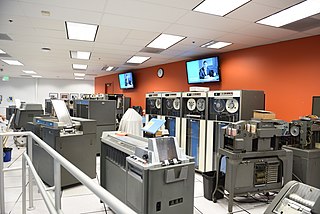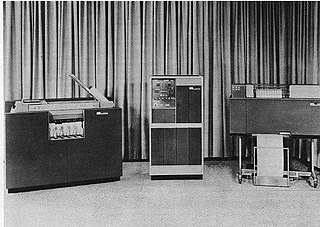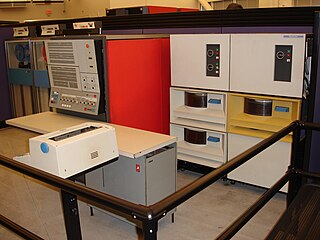
In computer programming, assembly language, sometimes abbreviated asm, is any low-level programming language in which there is a very strong correspondence between the instructions in the language and the architecture's machine code instructions. Because assembly depends on the machine code instructions, every assembly language is designed for exactly one specific computer architecture. Assembly language may also be called symbolic machine code.

In computer programming, machine code, consisting of machine language instructions, is a low-level programming language used to directly control a computer's central processing unit (CPU). Each instruction causes the CPU to perform a very specific task, such as a load, a store, a jump, or an arithmetic logic unit (ALU) operation on one or more units of data in the CPU's registers or memory.

The IBM System/360 (S/360) is a family of mainframe computer systems that was announced by IBM on April 7, 1964, and delivered between 1965 and 1978. It was the first family of computers designed to cover the complete range of applications, from small to large, both commercial and scientific. The design made a clear distinction between architecture and implementation, allowing IBM to release a suite of compatible designs at different prices. All but the only partially compatible Model 44 and the most expensive systems use microcode to implement the instruction set, which features 8-bit byte addressing and binary, decimal and hexadecimal floating-point calculations.

The IBM 1620 was announced by IBM on October 21, 1959, and marketed as an inexpensive "scientific computer". After a total production of about two thousand machines, it was withdrawn on November 19, 1970. Modified versions of the 1620 were used as the CPU of the IBM 1710 and IBM 1720 Industrial Process Control Systems.

The IBM 1401 is a variable-wordlength decimal computer that was announced by IBM on October 5, 1959. The first member of the highly successful IBM 1400 series, it was aimed at replacing unit record equipment for processing data stored on punched cards and at providing peripheral services for larger computers. The 1401 is considered to be the Model-T Ford of the computer industry, because it was mass-produced and because of its sales volume. Over 12,000 units were produced and many were leased or resold after they were replaced with newer technology. The 1401 was withdrawn on February 8, 1971.

The IBM 650 Magnetic Drum Data-Processing Machine is an early digital computer produced by IBM in the mid-1950s. It was the first mass produced computer in the world. Almost 2,000 systems were produced, the last in 1962, and it was the first computer to make a meaningful profit. The first one was installed in late 1954 and it was the most-popular computer of the 1950s.
UNIVAC was a line of electronic digital stored-program computers starting with the products of the Eckert–Mauchly Computer Corporation. Later the name was applied to a division of the Remington Rand company and successor organizations.

The IBM 7090 is a second-generation transistorized version of the earlier IBM 709 vacuum tube mainframe computer that was designed for "large-scale scientific and technological applications". The 7090 is the fourth member of the IBM 700/7000 series scientific computers. The first 7090 installation was in December 1959. In 1960, a typical system sold for $2.9 million or could be rented for $63,500 a month.

The IBM 700/7000 series is a series of large-scale (mainframe) computer systems that were made by IBM through the 1950s and early 1960s. The series includes several different, incompatible processor architectures. The 700s use vacuum-tube logic and were made obsolete by the introduction of the transistorized 7000s. The 7000s, in turn, were eventually replaced with System/360, which was announced in 1964. However the 360/65, the first 360 powerful enough to replace 7000s, did not become available until November 1965. Early problems with OS/360 and the high cost of converting software kept many 7000s in service for years afterward.

The IBM 1130 Computing System, introduced in 1965, was IBM's least expensive computer at that time. A binary 16-bit machine, it was marketed to price-sensitive, computing-intensive technical markets, like education and engineering, succeeding the decimal IBM 1620 in that market segment. Typical installations included a 1 megabyte disk drive that stored the operating system, compilers and object programs, with program source generated and maintained on punched cards. Fortran was the most common programming language used, but several others, including APL, were available.

The IBM System/3 was an IBM midrange computer introduced in 1969, and marketed until 1985. It was produced by IBM Rochester in Minnesota as a low-end business computer aimed at smaller organizations that still used IBM 1400 series computers or unit record equipment. The first member of what IBM refers to as their "midrange" line, it also introduced the RPG II programming language. It is the first ancestor in the product line whose current version is the IBM i series and includes the highly successful AS/400.

The IBM 1400 series were second-generation (transistor) mid-range business decimal computers that IBM marketed in the early 1960s. The computers were offered to replace tabulating machines like the IBM 407. The 1400-series machines stored information in magnetic cores as variable-length character strings separated on the left by a special bit, called a "wordmark," and on the right by a "record mark." Arithmetic was performed digit-by-digit. Input and output support included punched card, magnetic tape, and high-speed line printers. Disk storage was also available.
Autocoder is any of a group of assemblers for a number of IBM computers of the 1950s and 1960s. The first Autocoders appear to have been the earliest assemblers to provide a macro facility.

The Honeywell 200 was a character-oriented two-address commercial computer introduced by Honeywell in the early 1960s, the basis of later models in Honeywell 200 Series, including 1200, 1250, 2200, 3200, 4200 and others, and the character processor of the Honeywell 8200 (1968).
Gary Mokotoff (born April 26, 1937) is an author, lecturer, and Jewish genealogy researcher. Mokotoff is the publisher of AVOTAYNU, the International Review of Jewish Genealogy, and is the former President of the International Association of Jewish Genealogical Societies (IAJGS). He is the creator of the JewishGen's Jewish Genealogical Family Finder and the Jewish Genealogical People Finder. He co-authored the Daitch–Mokotoff Soundex system. Mokotoff is co-author of Where We Once Walked: A Guide to the Jewish Communities Destroyed in the Holocaust.
Basic Assembly Language (BAL) is the commonly used term for a low-level programming language used on IBM System/360 and successor mainframes. Originally, "Basic Assembly Language" applied only to an extremely restricted dialect designed to run under control of IBM Basic Programming Support (BPS/360) on systems with only 8 KB of main memory, and only a card reader, a card punch, and a printer for input/output — thus the word "Basic". However, the full name and the initialism "BAL" almost immediately attached themselves in popular use to all assembly-language dialects on the System/360 and its descendants. BAL for BPS/360 was introduced with the System/360 in 1964.
FARGO was the predecessor to the RPG programming language (RPG). FARGO was more of a utility program than a programming language, whereas RPG had a program generation process that produced an executable object.

The IBM System/360 Model 30 was a low-end member of the IBM System/360 family. It was announced on April 7, 1964, shipped in 1965, and withdrawn on October 7, 1977. The Model 30 was designed by IBM's General Systems Division in Endicott, New York, and manufactured in Endicott and other IBM manufacturing sites outside of U.S.

The IBM System/360 Model 20 is the smallest member of the IBM System/360 family announced in November 1964. The Model 20 supports only a subset of the System/360 instruction set, with binary numbers limited to 16 bits and no floating point. In later years it would have been classified as a 16-bit minicomputer rather than a mainframe, but the term "minicomputer" was not current, and in any case IBM wanted to emphasize the compatibility of the Model 20 rather than its differences from the rest of the System/360 line. It does, however, have the full System/360 decimal instruction set, that allows for addition, subtraction, product, and dividend of up to 31 decimal digits.

The IBM System/360 Model 25 is a low-end member of the IBM System/360 family. It was announced on January 3, 1968, 3 years before the IBM System/360 Model 22, as a "bridge between its old and new computing systems".














